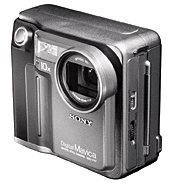|
Rain forests around the world--safari
Two teachers share their experience creating a Rain Forest Safari at their school using
QTVR.
By Sandra Cameron and Mary Goddard
|
|
 or
several years the Sixth Grade team at Plattsmouth Community Middle School
in Plattsmouth, Nebraska has taught an interdisciplinary unit on the
rain forest. For the culminating activity the class goes to the Henry Doorly Zoo's Lied Jungle in
Omaha, Nebraska. Every year there have been students who cannot go on
the field trip. What could we do to allow these students experience
the Lied Jungle from school? or
several years the Sixth Grade team at Plattsmouth Community Middle School
in Plattsmouth, Nebraska has taught an interdisciplinary unit on the
rain forest. For the culminating activity the class goes to the Henry Doorly Zoo's Lied Jungle in
Omaha, Nebraska. Every year there have been students who cannot go on
the field trip. What could we do to allow these students experience
the Lied Jungle from school?
|
|

Sony Mavica FD-7 camera
| |  e discovered that using
QuickTime Virtual Reality (QTVR) movies, the scenes of the jungle could be
duplicated on the computer. With the cooperation of the zoo's educational
curator, we were given access to the Lied Jungle before opening. Using a Sony
Mavica FD-7, a Kaidan tripod head, and a tripod we took pictures of the animals
and plants of the rain forest. The Mavica was mounted to the tripod head to take
panoramic pictures. To mount the camera onto the tripod head, we had to center
the lens of the camera over the tripod. If the camera was not centered, the
pictures would not have overlapped to make the panoramic QTVR movies. Leveling
the tripod head was tricky. The sidewalks in the jungle were dirt paths or
sloped concrete. e discovered that using
QuickTime Virtual Reality (QTVR) movies, the scenes of the jungle could be
duplicated on the computer. With the cooperation of the zoo's educational
curator, we were given access to the Lied Jungle before opening. Using a Sony
Mavica FD-7, a Kaidan tripod head, and a tripod we took pictures of the animals
and plants of the rain forest. The Mavica was mounted to the tripod head to take
panoramic pictures. To mount the camera onto the tripod head, we had to center
the lens of the camera over the tripod. If the camera was not centered, the
pictures would not have overlapped to make the panoramic QTVR movies. Leveling
the tripod head was tricky. The sidewalks in the jungle were dirt paths or
sloped concrete.
|
|
 he Kaidan tripod head is specially made for taking panoramic pictures. The
Kaidan head has a disc that stops the camera every 18 degrees. To make one
panoramic movie you must take 21 pictures sequenced around the tripod. After
taking the pictures we used the program Quick Time Authoring Studio to stitch the
pictures together into a QTVR movie.
he Kaidan tripod head is specially made for taking panoramic pictures. The
Kaidan head has a disc that stops the camera every 18 degrees. To make one
panoramic movie you must take 21 pictures sequenced around the tripod. After
taking the pictures we used the program Quick Time Authoring Studio to stitch the
pictures together into a QTVR movie.
|
|
 Primate photo taken at the Lied Jungle.
Primate photo taken at the Lied Jungle.
| |  ack at school, we created
HyperStudio stacks that had factual information (Genus/Species, Class, Order,
Family, Range, Adaptations, Social Behavior, Reproduction/Young, Feeding
Type/Diet, Status, and Special Notes) about each of the flora and fauna found in
the Lied Jungle. We placed a picture of the plant or animal on each page to
accompany the facts. Next we created hypertext links that allowed students to
look up words that they did not understand as well as links to show the student
the part of the world that the plant or animal came from. ack at school, we created
HyperStudio stacks that had factual information (Genus/Species, Class, Order,
Family, Range, Adaptations, Social Behavior, Reproduction/Young, Feeding
Type/Diet, Status, and Special Notes) about each of the flora and fauna found in
the Lied Jungle. We placed a picture of the plant or animal on each page to
accompany the facts. Next we created hypertext links that allowed students to
look up words that they did not understand as well as links to show the student
the part of the world that the plant or animal came from.
|
|
|
 he next step was to create
slideshows of still photos to entice the learner into further exploration
of the stacks. We created two stacks for each separate part of the jungle
(example, Asia). One stack was targeted for younger learners while the
other stack was to be used by middle school learners. Each stack had
the links for definitions and maps. Sounds of the rain forest were included
in the stacks to give the impression of being there. This way students
were able to get a feel for the jungle from school. he next step was to create
slideshows of still photos to entice the learner into further exploration
of the stacks. We created two stacks for each separate part of the jungle
(example, Asia). One stack was targeted for younger learners while the
other stack was to be used by middle school learners. Each stack had
the links for definitions and maps. Sounds of the rain forest were included
in the stacks to give the impression of being there. This way students
were able to get a feel for the jungle from school.
| |
 Waterfall at the Lied Jungle.
Waterfall at the Lied Jungle.
| |  fter visiting the zoo--in
reality or virtually, the sixth grade students developed a Rain Forest Safari for
first graders using learning stations. First grade students were read a story
about the rain forest. They sampled food products and graphed their likes and
dislikes, listened to music, made a small terrarium, and viewed a slideshow about
the rain forest from the HyperStudio Stacks. fter visiting the zoo--in
reality or virtually, the sixth grade students developed a Rain Forest Safari for
first graders using learning stations. First grade students were read a story
about the rain forest. They sampled food products and graphed their likes and
dislikes, listened to music, made a small terrarium, and viewed a slideshow about
the rain forest from the HyperStudio Stacks.
To prepare for their journey to the rain forest
jungle, the first grade students needed to make safari hats and binoculars. The
safari hats were made with a band of paper around the head and the shape of a
Panama hat stapled to the front of the band. The binoculars were made by
gluing two toilet paper rolls together and hanging them around the student's
necks with string. The students came dressed with these materials to the Rain
Forest Safari. After the safari, the primary teachers were able to take the
Elementary HyperStudio stacks back to the classroom to further their students'
knowledge about the rain forest.
|
|
 verall,
project was a great success! The QTVR movies and HyperStudio stacks worked well
within the school's network. The sixth grade students were excited by the QTVR
movies and the still pictures. They were eager to learn how to make their own
movies. The students have applied the QTVR technology by creating their own
stacks in other subject areas. verall,
project was a great success! The QTVR movies and HyperStudio stacks worked well
within the school's network. The sixth grade students were excited by the QTVR
movies and the still pictures. They were eager to learn how to make their own
movies. The students have applied the QTVR technology by creating their own
stacks in other subject areas.
Although the project was successful within our
school's network, trying to share this project with other school districts
through the World Wide Web has not been successful. The HyperStudio stacks were
too large. They needed Netscape to have 20 or more megabytes of RAM to
successfully load one stack. In spite of this challenge, we believe this
technology has great potential for enhancing many subject areas. Schools can now
take advantage of the growing number of resources on the Web that utilize QTVR.
|
|
|
|

|
Sandra Cameron and Mary Goddard
are educators from Plattsmouth, Nebraska.
Teacher Testimony authors are
nominated by people like you. Send nominations to the editor.
© 1997, 1998, 1999, 2000 SCR*TEC.
This page is Bobby
Approved.
|
|
|





 Waterfall at the Lied Jungle.
Waterfall at the Lied Jungle.